Letters from Lodi
An insightful and objective look at viticulture and winemaking from the Lodi
Appellation and the growers and vintners behind these crafts. Told from the
perspective of multi-award winning wine journalist, Randy Caparoso.
Why, in Lodi, the finest sparklers are made from Assyrtiko, Albariño, Piquepoul, Bacchus, Clairette blanche, Grenache and Carignan
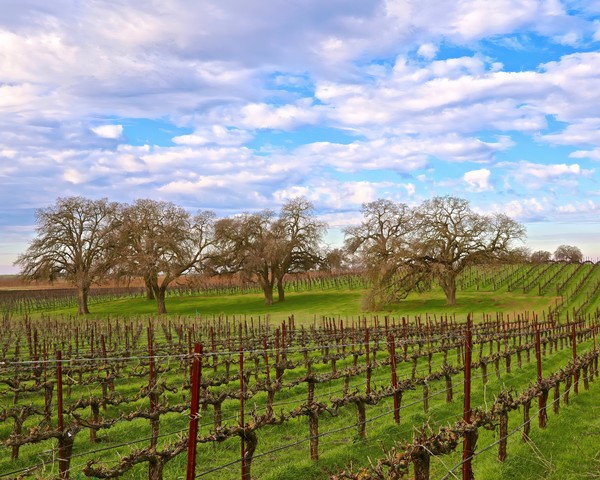
Clements Hills-Lodi's Terra Alta Vineyard, source of both Piquepoul and Albariño now going into some of California's most exciting alternative style champagne method sparkling wines.
One of the beauties of a warm climate region such as Lodi is that you can now find sparkling wines made from alternative grapes more naturally adapted to Mediterranean climate zones.
Not that Chardonnay and Pinot noir—the two primary grapes of France’s famed Champagne region—aren’t found in Lodi. There is, in fact, plenty of Chardonnay and Pinot noir grown in the region, much of it planted to supply big name sparkling wine producers out on the coast. A minuscule percent of the Chardonnay and Pinot noir grown in Lodi does go to local wineries producing classically inspired champagne method wines such as LVVR, Nostra Vita, Peltier Winery and Michael David Winery.
Recently, though, even LVVR Sparkling Cellars, which started off as a “traditional” house, has been exploring champagne method production of wines made from non-traditional grapes such as Albariño, Verdelho and Barbera. As you would expect, these wines are more fragrant than typical Pinot noir/Chardonnay based sparklers, yet are marked by similar yeasty (i.e., rising bread dough-like scents) qualities expected in champagne method bottlings.
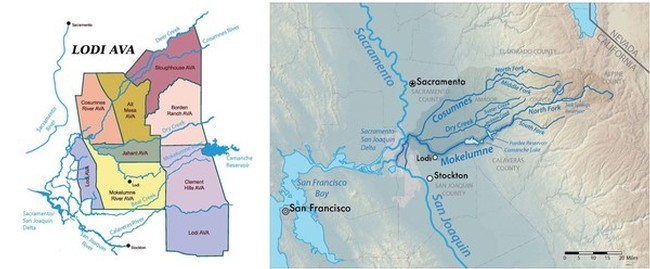
Maps of the Mokelumne River watershed and boundaries of the Lodi appellation in immediate proximity to the California Delta spilling into San Francisco Bay, the natural factors accounting for the ocean-influenced Mediterranean climate of the region and, ultimately, the ease in which grapes of Mediterranean origin ripen with optimal maturity and acid balance.
The movement towards non-traditional sparklers make sense, mostly because Lodi does indeed specialize in grapes that are intrinsically adapted to warmer climate viticulture. Meaning, grape varieties that ripen well in a Mediterranean climate, yet retain the natural acidity that is essential to high quality champagne style wines.
Before we delve further into the subject, it is important to clarify one of the most common misperceptions about champagne method production, which is the assumption that grapes have to be grown in ultra-cold climates, such as what you find in France’s Champagne region, to retain the requisite acidity as well as lower sugar grape maturation in order to achieve the delicacy (i.e., finished alcohol levels in the 12%-13% ABV range) usually expected in good sparkling wines.
The prerequisite for successful champagne method production, however, is not climate, it is grape selection. For instance, after Champagne, the second largest champagne method region in the world is Penedès in Spain, located right alongside the Mediterranean Sea south of Barcelona. As in Lodi, the climate in Penedès is squarely “Mediterranean” (i.e., cool, wet winters/dry warm to hot summers), much warmer than France’s Champagne region.

Regions adjacent to the Mediterranean Basin where some of the cultivars grown in Lodi were orginally adapted, thus yielding grapes of high enough acidity to produce balanced table wines as well as fresh and delicate sparkling wines.
Although there is a smattering of Chardonnay grown in Penedès, the region’s cava (the Spanish word for traditional champagne method sparkling wine) production is based on three grapes of native origin—Macabeo (a.k.a., Viura), Parellada and Xarel-lo—all of which ripen with all the natural acidity necessary for high quality sparkling wine production. In Penedès, in other words, a cold climate is not necessary to cultivate high acid grapes. The native varieties do just fine.
If that’s the case, you might ask, why doesn’t Lodi grow Macabeo, Parellada and Xarel-lo? As a matter of fact, as we speak Lodi’s Bokisch Vineyards is putting the finishing touches on California’s first-ever cava style wine made from these three Catalan grapes, planted in Lodi’s Clements Hills AVA in 2018. The first release is scheduled for mid-April, and we promise to talk more about this when that time comes.
But for now, let us summarize recent conversations with Lodi vintners about the small pack of fun, exciting—and I should add, absolutely first class—alternative style sparkling wines now available to anyone with enough gumption to seek them out.

The beauty of Lodi as an appellation is that black skinned cultivars such as Grenache and Carignan (going into this nonvintaged, traditional method wine) ripen with plenty of natural acidity, although the grapes were picked early enough for this bottling to finish at a light and easy alcohol level of 11.4% ABV. The nose and palate-feel blends suggestions of strawberry and pomegranate with a classic champagne yeastiness.
According to Klinker Brick winemaker Joseph Smith, “Our Brut Rosé is a 50/50 blend of Grenache and Carignan, which were fermented separately before being blended. We chose these varieties because we wanted to step outside the box and get away from the obvious expectations of most sparkling rosés done in California. Our still rosé made from Grenache and Carignane were such a hit, it just made sense to make a champagne style wine from the same grapes, sourced from the exact same vineyards.”

Longtime Klinker Brick Winery winemaker Joseph Smith.
For sparkling wine production, Smith has no fear of picking black skinned grapes at a very low sugar (averaging 17.2° Brix, or sugar reading) and fairly high acidity (3.06 pH, or strength of acidity). It works for sparkling wines because all you need is a subtlety (not intensity) of fruit scent, which only enhances an overall feel of lightness, crispness and dryness, despite a touch of residual sugar (7 grams) added in the dosage to brighten the nose.
“After two vintages of producing sparkling wine,” adds Smith, “we now feel that we are hitting that point of perfection, and we’re very pleased with where we are with this wine.”

If you want to get in on absolutely the latest, and perhaps freshest and most daring, of Lodi’s alternative style sparkling wines, look no further. According to Jeff Perlegos, who operates the brand with his brother John, “All of the fruit for this cuvée is grown by our family on our vineyard property in the village of Clements [on the eastern edge of the Lodi appellation]. This is most likely the first sparkling Assyrtiko made in the country.”
The sparkler has the honeyed fragrance of the grape tinged with a yeastiness resulting from 16 months spent in contact with lees (i.e., spent yeast cells) in the bottle. The taste is feathery light (alcohol content, 12% ABV), lemony/citrus peel tart, delicate and faintly briny in its minerality.
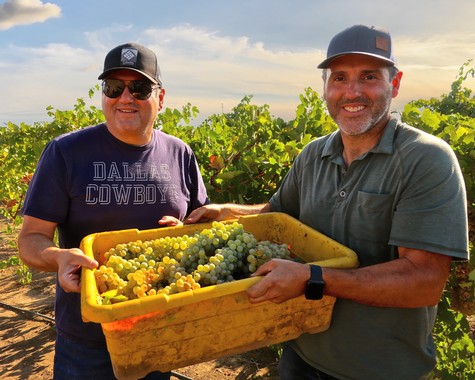
Perlegos Family's John and Jeff Perlegos harvesting Assyrtiko.
Assyrtiko is a particular point of pride for the Perlegos Family because of their Greek lineage; the cultivar closely associated with the islands of Greece (most famously, Santorini), where viticulture goes back thousands of years. According to Jeff, “In 2023 we picked the Assyrtiko for our sparkling wine [the family also produces a table wine from Assyrtiko] at 20° Brix and 2.9 pH. I think the more we learn to farm this variety, the more we’ll be able to achieve a sufficient quality at even lower pH [generally speaking, the lower the pH in grapes and wines, the higher the acidity]."
As a way of explaining why Assyrtiko makes a natural choice for sparkling wine production in Lodi, Perlegos says: “I believe most varieties around Lodi, when picked for sparkling wine at 19° or up to 20.5° Brix, do hold their acidity quite well, as does Assyrtiko. Farming, weather, soil structure and grape variety are all factors, but for the most part, once you hit 20° Brix or more, grape acids fall out quickly, if not managed for it. By way of contrast, for non-sparkling table wines such as Zinfandel, pH generally falls around 3.2 to 3.45 when grapes are picked as high as 25° Brix—good acidity for red wines, not so much for sparkling.”
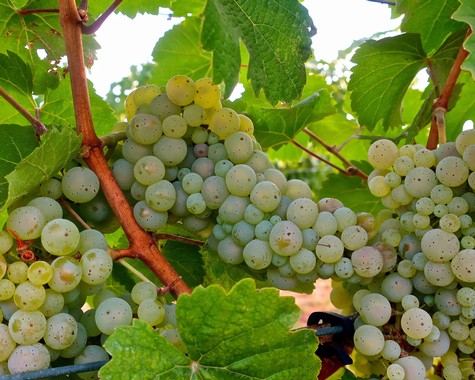
Bacchus grapes in Lod's Mokelumne Glen Vineyard.
Stunningly unique and delicate, this tiny lot champagne style wine was crafted entirely from a German cultivar called Bacchus—a 1933 crossing of (Silvaner x Riesling] and Müller-Thurgau (Riesling x Madeleine Royale)—cultivated by Lodi's Mokelumne Glen Vineyard since the late 1990s.
Bacchus became a very popular grape in Germany because it readily adapted to warmer regions such as Rheinhessen and Franconia, where the climate is classified as continental (meaning, extreme temperature variance, from icy winters to sun soaked summers) yet still characterized by warm, dry summers akin to what you find in Mediterranean climate zones. Therefore, when the Koth family first planted some three dozen grapes of German origin in Lodi's Mokelumne River AVA, Bacchus was among the grapes responding best, yielding interestingly nuanced varietal profiles.
Besides possessing a fresh, perky acidity entirely natural to the grape, the Markus Wine Co. Sparkling Bacchus absolutely sings with intricate mineral, oil of lemon peel, wet stone, nectarine and pear-like scents, underlined by the brioche-like yeasty nuances (the result of a full year held en tirage, i.e., in contact with lees in the bottle) typical of champagne style sparklers.
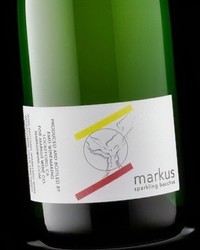
According to winemaker/owner Markus Niggli, “We decided upon Bacchus for our first sparkling wine because it is a grape that usually comes in a low Brix, not more than 18°, while barely hitting 3.0 pH [low even by most standards of champagne production around the world].”
Adds Niggli, “What you gain in freshness you might be short on flavors, but what did we find out by the end of this project was...
• It satisfied my need to try new things.
• We proved to ourselves that Bacchus works very well for sparkling production.
• As good as the wine is, it’s still hard to sell because most people don’t know the varietal and there isn’t an existing market market for it.
• Our project worked as brut nature (i.e., no sugar added in the dosage) because but the minute you talk about added sweetness I believe the wine gets too fat and therefore too much of a mouth-feel
• Once the grape gets too ripe (20° Brix or higher) the acidity falls out quickly, which does not work well for sparkling wine.
• Lodi’s Mokelume Glen Vineyard’s location alongside the river makes for very cold mornings, which is a big reason that grape acids hold nicely even during the warm summer days.”

This champagne method sparkler is edgy with lemony, lip smacking acidity, dryness, and much more subtly scented than expected considering the naturally floral nature of the grape, finishing with a sense of lightness (12.5% ABV) and more of a briny minerality than fruitiness.
Albariño is not technically a Mediterranean grape because it originated in the coastal areas of Spain and Portugal along the Atlantic Ocean rather than the Mediterranean Sea. Then again, Lodi as well as most of California's coastal wine regions are all classified as Mediterranean climate zones, even though they are over 6,000 miles away from the Mediterranean Sea. Point being, Albariño responds extremely well to Pacific-influenced wine regions defined by mild winters and dry summers marked by significant diurnal swings (i.e., day/night temperature variance).
According to Markus Bokisch, “We began with a sparkling Albariño in 2018 because we had just planted our three Catalan grapes for cava production that year. It was also our belief that Albariño would be well matched for sparkling wine production. The grape has great natural acidity, and when picked early enough, it lends itself to a vibrant, citrus-driven, and briny profile that pairs well with almost any seafood dish.”
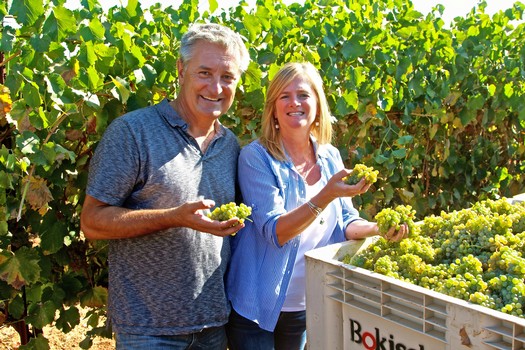
Markus and Liz Bokisch during their Terra Alta Vineyard Albariño harvest.
2022 Acquiesce Winery, Mokelumne River-Lodi Sparkling Clairette Blanche ($55)
2021 Acquiesce Winery, Mokelumne River-Lodi Sparkling Grenache Rosé ($55)
Although it is not currently in their line-up, in the past Acquiesce has also produced a Sparkling Grenache Blanc. All told, no winery in Lodi has done as much with alternative style méthode Champenoise style sparklers; in the case of Acquiesce, sparklers made from “Rhône” varieties eminently suited to Lodi’s Mediterranean climate.
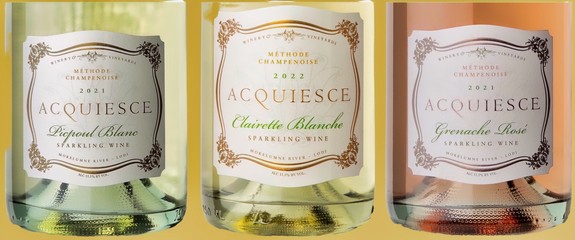
If you like lemony tartness and lightness—with more steeliness than typical Prosecco, yet more delicacy than most cava from Spain—the Sparkling Picpoul Blanc is right up your alley. The sparkler’s playful mingling of green apple, lemon skin and rising bread dough almost bely the wine’s ultra-light profile, which comes across with a real sense of delicacy.
I can almost guarantee, though, that you will never find a champagne method wine quite like the brand’s Sparkling Clairette Blanche, made from a Southern French grape known for its combination of white flower, mineral and herbes de Provence-like nuances, stronger in this wine’s sharp/savory palate-feel than what is sensed in its subtle nose. The wine is vibrant, vivacious, and certainly memorable in its unique profile.
While maintaining nearly an equal amount of grace, I find Acquiesce’s Grenache Rosé to be a tad fuller than its two sparkling stablemates, most likely because it was finished with a dosage of 3 grams residual sugar (still a technically “dry” wine) to enhance a subtly scented red berry profile that winemaker Christina Lopez describes as “watermelon agua fresca.” Yet the wine finishes with a steely, mildly minerally yet airy light feel.
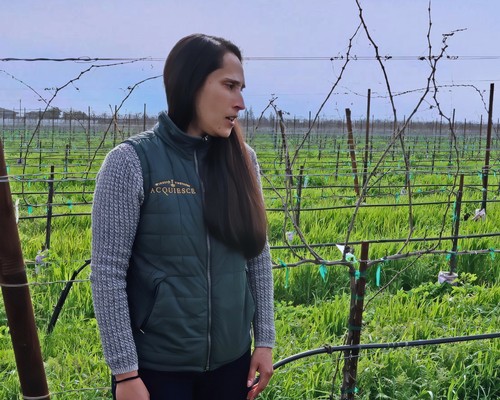
Acquiesce winemaker/vineyard manager Christina Lopez among the estate's regeneratively farmed grapevines in early spring.
Generously sharing her insights on the thought process behind these three adventurous sparklers, Ms. Lopez tells us:
“The mindset is totally different when picking for sparkling as opposed to still wines. The crucial element for us is to capture the moment when the variety is just beginning to show character while maintaining the energy that acid provides. We generally start to see this around 18° Brix.
“At that point, these Rhône varieties have plenty of acid to show. Each variety is different, but we typically see pHs around 3.25 and TAs [i.e., total acidity] between 6.5-7.5 g/L. For instance, in 2022 we played with Clairette blanche as a sparkler. While not known for being a high acid grape, it does bring mid-palate volume to the table. This breadth of flavor gives the perception of sweetness, so we opted for no dosage in the finished wine [hence, a “natural” style with zero residual sugar].
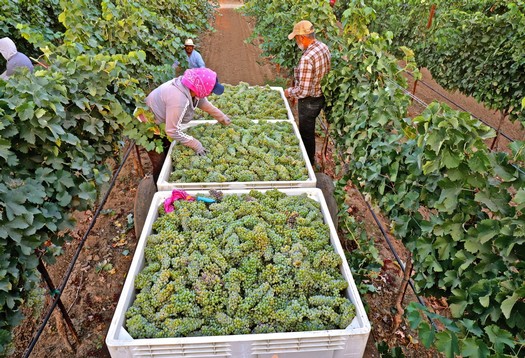
Clairette blanche harvest in Mokelumne River-Lodi's Acquiesce estate.
“This proved to us that you don’t necessarily need the highest acid variety to make balanced bubbles. While Lodi is considered a ‘hot climate,’ the key to making singular, distinct, and delicious wines is having the right varieties in the right place.
“Picpoul blanc is more of a natural grape for sparkling wine because the variety is inherently high in acid and malleable in the winery. So we did some bâtonnage [i.e., stirring of lees in tank] before going into the bottle for tirage [the step when sugar and yeast are added to start a secondary fermentation] to temper acidity and get a jump start on lees contact.
“Grenache, a black skinned grape that we usually use to produce rosé, is very responsive to terroir [i.e., growing conditions leading to 'sense of place' in a wine], so we thought it’d be fun to try it out as a sparkler. One difference that we see with Grenache is that it takes a touch longer to hit that crucial element of pH/TA balance, so we have to be out in the vineyard a lot more, tasting the fruit, before making a picking decision.”

It is natural to compare Lorenza's Sparkling Picpoul Blanc with that of Acquiesce's. The similarities⏤lemon skin scent, rapier acidity and breezy lightness⏤are there because lemon, elevated acidity and lightness of body are signature characteristics of the grape, whether grown in Lodi or its native region Picpoul de Pinet in the South of France.
The big difference between Acquiesce’s Sparkling Picpoul Blanc and Lorenza's iteration is that the Lorenza is made by Charmat method (contact with yeast cells taking place in a tank, as opposed to individual bottles as it is done for champagnes). If anything, Lorenza's method accentuates the natural varietal character of the grape, particularly its refreshingly acid driven (lemony tart and apple/pear crispness) profile, although the wine comes across as refined, delicate (a feathery light 10.8% ABV), a tad briny in its minerality and, of course, suitably efferverscent—the barest touch of residual sugar (2 grams) balancing the tart varietal typicité.
According to Lorenza owner/winemaker Melinda Kearney, who also produces an outstanding non-sparkling table white from the Piquepoul grape, "Given our previous experience making still wines from the variety, we knew that the purity of fruit [which sees no oak or malolactic fermentation] and brightness of its expression likely would lend itself well to what we like to call ‘starlight in a glass.’”
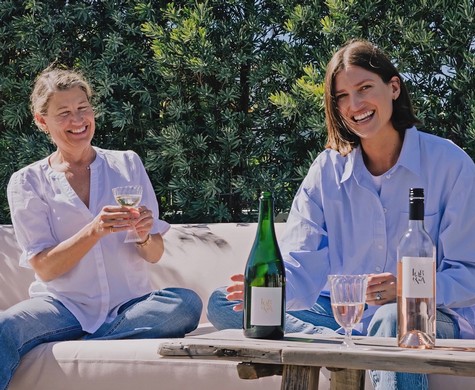
The mother/daughter team behind Lorenza Wine, Melinda Kearney and Michèle Ouellet Benson. Lorenza Wine.
Adds Kearney, on the differences between the still and sparkling versions of the grape: “It is interesting to see the effects of secondary fermentation. Both our still and sparkling versions of the varietal are made from the same base wine, but secondary fermentation shifts the emphasis from citrus to pear and apples in the profile."
How well does Piquepoul retain its acidity in Lodi? Surprisingly, fruit for Lorenza’s 2023 Sparkling Picpoul Blanc—sourced from Bokisch family’s Terra Alta Vineyard in the hillsides of Lodi’s Clements Hills appellation—was not picked until October 3. In 2024 the fruit came in on September 18 at a sugar level of just 17.1° Brix and harvest pH around 3.4—still low enough for this grape which is defined by a sharp lemony varietal profile. It bears mention, of course, that the relatively low vigor, shallow, gravelly clay soil of the Terra Alta site also contributes to the slower maturation of Lorenza’s grapes (whereas the Acquiesce estate sits on a richer, deeper sandy loam soil).
By comparison, however, when Pinot noir and Chardonnay are picked for sparkling wine production in Lodi, harvests are usually six to eight weeks sooner, usually in late July, early August at the latest. To repeat our post’s point of emphasis: To produce optimal quality sparkling wine in a region such as Lodi, the primary factor is grape selection, not climate, and there is more variety of wine grapes commercially grown in Lodi than in any other region in the country.
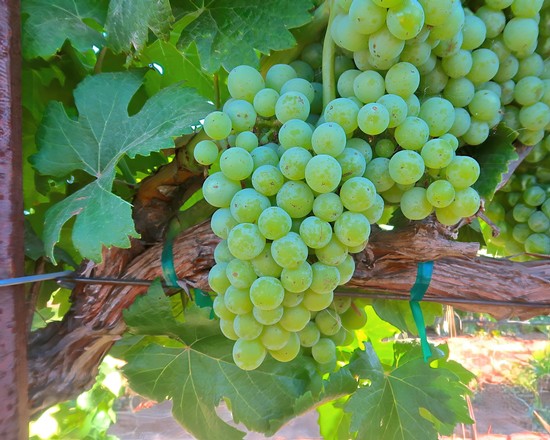
Piquepoul in Clements Hills-Lodi's Terra Alta Vineyard in July, still at least six weeks away from harvest.